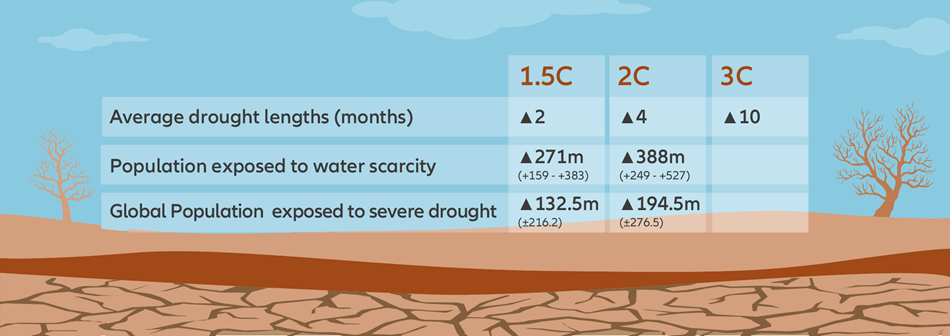The water scarcity challenge and the cost of inaction

Summary
Physical and economic water scarcity have both drastic societal and economic effects. An increasing (urban) population with a growing demand for food, climate change causing more extreme weather and an aging infrastructure are the main drivers for water scarcity and water stress. Water scarcity is a significant barrier to economic growth, not only in already water-scarce regions
- Physical and economic water scarcity have both drastic societal and economic effects
- An increasing (urban) population with a growing demand for food, climate change causing more extreme weather and an aging infrastructure are the main drivers for water scarcity and water stress
- Water scarcity is a significant barrier to economic growth, not only in already water-scarce regions
- Corporates are facing heightened risks in absence of adaptive measures or from lacking investments in addressing water risks
- Investments in innovators offering water-efficiency solutions can help to address water scarcity contributing to protect the world’s food supply
The water scarcity challenge and the cost of inaction
Throughout 2021 the world was plagued with disastrous weather events, from hurricanes and flooding to unprecedented droughts. This severe weather disrupted access to clean water supply, negatively impacting the livelihoods of many communities around the world. For example, Texas experienced infrastructure failure following severe and unusual winter weather, while Taiwan experienced its worst drought in 56 years, which posed challenges for semiconductor production. Communities in Germany and China also faced challenges, as the nations were victims of life-threatening floods. While the water scarcity challenge has been worsening, these severe weather events have further highlighted the need for urgent action to address inadequate infrastructure, adapt drainage systems, and enhance water-use efficiency.
Together with the mostly uncontrolled burning of agricultural and municipal waste, the combustion and evaporation of fossil fuels – mainly from power plants, industry and vehicle engines – represent the main source of polluted air.
|
More than a billion people live in water-scarce regions, and as many as 3.5 billion could face water scarcity by 20251 |
Water scarcity – a definition
Water scarcity refers to a physical shortage, or lack of access to renewable water supplies (economic water scarcity). This is typically tied to lack of infrastructure, or a failure to secure an adequate water supply.2
That said, wherever water demand outpaces water supply, or infrastructure is aging or lacking, a region may face the risk of water scarcity. As demand for water continues to exceed water supply, more and more of the world is likely to experience water-related challenges. For example, 20% of global GDP is already produced in regions experiencing water scarcity.3

Source: World Resources Institute: “It Could Only Cost 1% of GDP to Solve Global Water Crises”, January 2020
Water scarcity drivers
Water supply disruption
The increase in demand is not the only driver of water scarcity, as challenges with water supply and water infrastructure can also play a role. For example, as climate change continues to drive more extreme weather, such as severe floods or hurricanes, existing water infrastructure will be put to the test, often resulting in failures. These failures will further drive water scarcity, as freshwater resources will not be effectively distributed, and the quality of the freshwater is likely to be negatively impacted. Additionally, changing weather patterns also impact levels of precipitation, as well as the form of precipitation. For example, whether precipitation comes in the form of snow or rain determines how long the resource can be preserved, and when it can be utilised. In regions where snow is usually the dominant form, yet rain is experienced, the freshwater resource cannot be effectively preserved for use in the drier spring and summer months.
An ever-growing (urban) population
In parallel to water scarcity triggered by climate change, population growth is contributing to a growing water-supply demand imbalance. Additionally, as incomes rise in emerging economies, a higher disposable income will result in lifestyle changes which impact the level of water demanded. For example, as more people can afford to live middle-class lifestyles, water demand will increase to support a more water-intensive diet or overall lifestyle. Additionally, many of these populations are gravitating toward cities which are already facing water scarcity.
According to research, in 2016 around 933 million urban residents globally lived in water-scarce regions. By 2050, this number could double, reaching between 1.693 and 2.373 billion (35–51%).4
|
Water use has been growing globally at more than twice the rate of population increase over the last century, and an increasing number of regions are reaching the limit at which water services can be sustainably delivered, especially in arid regions.5 |
Water scarcity triggers profound environmental and societal disruptions
Water scarcity has far-reaching societal and policy implications. It not only puts millions of people at risk of displacement, but also triggers bloody “water wars”, for example between herdsmen and crop farmers, or between users in urban and rural areas – especially during droughts, when water normally used for irrigation is diverted for urban use. This, in turn, can lead to significantly reduced agricultural output, with cascading effects on food security.
Worldwide, water-related conflicts are growing6 in parallel with an intensifying water demand. According to recent estimates, by 2050 the requirement for water could increase by 55%.7
|
“Drought is on the verge of becoming the next pandemic, and there is no vaccine to cure it.” |
While the debilitating consequences of water scarcity are commonly associated with water-scarce regions in developing countries, highly concerning water challenges have already arrived at the doors of the European continent.
According to the European Commission,9 11% of the European population (equivalent to 52 million people) are living in water-scarce regions, mostly in countries in southern Europe where water stress periods can last for several months.

Source: UN Summary Progress Update 2021: SDG 6 — water and sanitation for all
Summary Progress Update 2021: SDG 6 — water and sanitation for all | UN-Water (unwater.org)
Although progress is being made, there are still major challenges ahead. NASA views water scarcity as the environmental ‘challenge of the century’.10 That said, there is a glimmer of hope if the goals of the Paris agreement are met; however, global society continues to struggle to address climate change.
“Between 184 and 270 million fewer people are projected to be exposed to increases in water scarcity in 2050 at about 1.5 degrees Celsius warming than at 2 degrees warming.” 11
Climate change-related scenarios elaborated by the UK-based website Carbon Brief12 depict a similar and no less alarming picture of the impact of different temperature levels on the global water supply and water availability:

The costs of inaction
Scarce supplies of water also have a significant financial and economic impact. The UN has predicted that:
- regions suffering from water scarcity could see their growth rates decline by 6% of GDP by 2050.13
- from 1998 to 2017 droughts have already impacted 1.5bn people, and cost over USD 124bn14
Corporates across all sectors are also increasingly facing financial risk from lack of investment in addressing water risks. Reports suggest that in 2020 water risks cost corporates USD 301bn, but if they had taken preventative action the cost would have been reduced to USD 55bn. As water scarcity continues to worsen, the cost of inaction is only going to increase.
In addition, the costs resulting from the absence of appropriate adaptation measures put further pressure on corporates, as highlighted by an analysis of S&P Global Ratings.15 This report states that, by the year 2050, 24 large U.S. investor-owned utilities would “face a heightened risk of water shortages”, and it further elaborates:
“Utility companies can be highly exposed to water scarcity, and the materiality of this exposure is greater for water-intensive assets, like power plants, in the absence of appropriate adaptation measures.”

Source: S&P Global Ratings: “Corporate Physical Assets Increasingly in Harm’s Way as Climate Change Intensifies”, October 2021
Allianz Global Investors – Delivering Sustainable Solutions
As water scarcity continues to present social and financial challenges around the world, sustainable water solutions are needed even more. Water efficiency solutions can help corporates in regions that are facing water stress do more with less, and avoid business disruptions, while also protecting the population from potential food supply shortages, as agricultural production can now be less water-intensive.
Allianz Global Investors believes in investing in companies offering market-leading water-efficiency solutions which enable society to manage through, and begin to effectively address, the very real water challenges.
Allianz Global Investors also believes in investing in the types of companies that produce irrigation solutions and AI technologies which allow farmers to significantly reduce the amount of water and fertilisers used on crops, ultimately protecting the world’s and freshwater resources.
Investments in such innovators help to direct financial flows to the most pressing water scarcity-related challenges, allowing investors to generate social and environmental alpha, while also capitalising on a long-term structural growth opportunity.
1. Source: International Fund for Agricultural Development: “The Water Advantage: Seeking sustainable solutions for water stress”, March 2018
2. Source: United Nations Office for Disaster Risk Reduction: “Special Report on Drought 2021”, June 2021
3. Source: HSBC: “Water scarcity: the growing threat: Very little of the world’s water is usable – and much is in inaccessible”, October 2021
4. Source: Nature Communications: “Future global urban water scarcity and potential solutions”, August 2021
5. Source: UN Water: “ Water Facts – Water Scarcity”, September 2018
6 Source: Conflict Map (worldwater.org)
7. Source: International Water Association, Cities of the Future Program
8. Source: UN Water: “New UNDRR report launched with stark warnings that drought could be next pandemic”, June 2021
9. Source: European Commission: “Water Scarcity and Drought in the European Union”, August 2010
10. Source: The Guardian, “Water shortages to be key environmental challenge of the century, Nasa warns”, May 2018
11. Source: Nasa: “A Degree of Concern: Why Global Temperatures Matter”, June 2019
12. Source: Carbon Brief Interactive: “The impacts of climate change at 1.5C, 2C and beyond”, October 2018
13. Source: World Bank: “High and Dry: Climate Change, Water, and the Economy”, May 2016
14. Source: United Nations Office for Disaster Risk Reduction, “Special Report on Drought 2021”, June 2021
15. Source: S&P Global: “Corporate Physical Assets Increasingly in Harm’s Way as Climate Change Intensifies”, October 2021
There is no guarantee that actively managed investments will outperform the broader market. Environmental, Social and Governance (ESG) strategies consider factors beyond traditional financial information to select securities or eliminate exposure which could result in relative investment performance deviating from other strategies or broad market benchmarks.
Information herein is based on sources we believe to be accurate and reliable as at the date it was made. We reserve the right to revise any information herein at any time without notice. No offer or solicitation to buy or sell securities and no investment advice or recommendation is made herein. In making investment decisions, investors should not rely solely on this material but should seek independent professional advice. However, if you choose not to seek professional advice, you should consider the suitability of the product for yourself. Investment involves risks including the possible loss of principal amount invested and risks associated with investment in emerging and less developed markets. Past performance of the fund manager(s), or any prediction, projection or forecast, is not indicative of future performance. This material has not been reviewed by any regulatory authorities.
Admaster: 2117875
The water scarcity challenge and the cost of inaction

Summary
Physical and economic water scarcity have both drastic societal and economic effects. An increasing (urban) population with a growing demand for food, climate change causing more extreme weather and an aging infrastructure are the main drivers for water scarcity and water stress. Water scarcity is a significant barrier to economic growth, not only in already water-scarce regions




